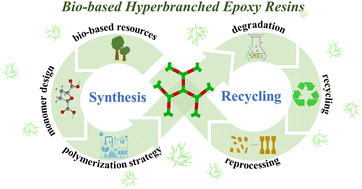Bio-based hyperbranched epoxy resins: synthesis and recycling
Abstract
Epoxy resins (EPs), accounting for about 70% of the thermosetting resin market, have been recognized as the most widely used thermosetting resins in the world. Nowadays, 90% of the world's EPs are obtained from the bisphenol A (BPA)-based epoxide prepolymer. However, certain limitations severely impede further applications of this advanced material, such as limited fossil-based resources, skyrocketing oil prices, nondegradability, and a “seesaw” between toughness and strength. In recent years, more and more research has been devoted to the preparation of novel epoxy materials to overcome the compromise between toughness and strength and solve plastic waste problems. Among them, the development of bio-based hyperbranched epoxy resins (HERs) is unique and attractive. Bio-based HERs synthesized from bio-derived monomers can be used as a matrix resin or a toughener resulting in partially or fully bio-based epoxy thermosets. The introduction of a hyperbranched structure can balance the strength and toughness of epoxy thermosets. Here, we especially focused on the recent progress in the development of bio-based HERs, including the monomer design, synthesis approaches, mechanical properties, degradation, and recycling strategies. In addition, we advance the challenges and perspectives to engineering application of bio-based HERs in the future. Overall, this review presents an up-to-date overview of bio-based HERs and guidance for emerging research on the sustainable development of EPs in versatile high-tech fields.

- This article is part of the themed collection: Celebrating the scientific accomplishments of RSC Fellows


 Please wait while we load your content...
Please wait while we load your content...